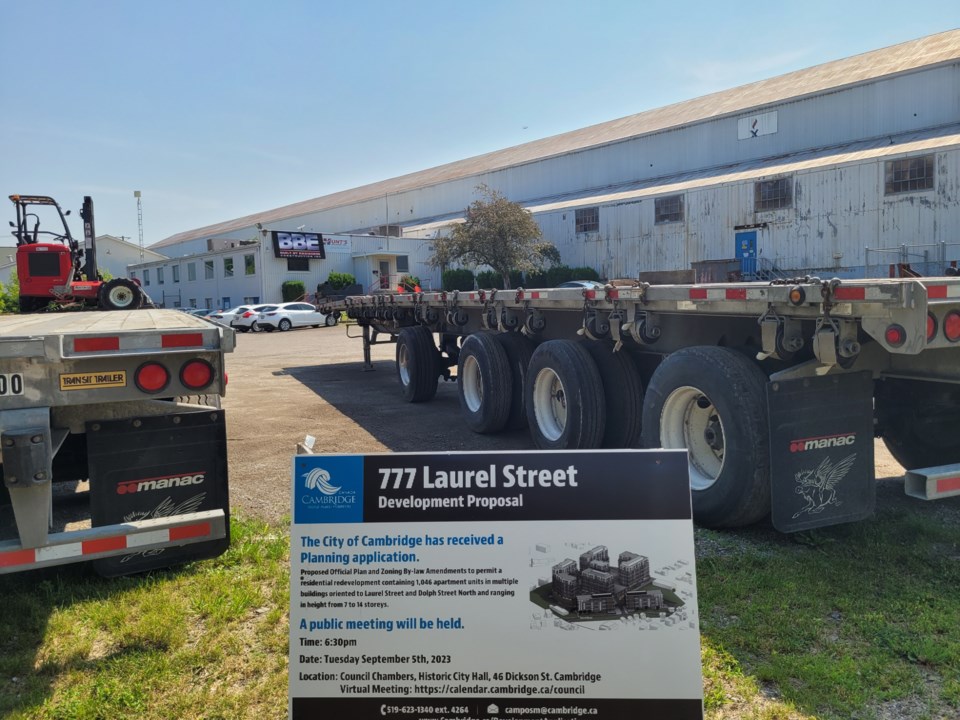This article was previously published on CambridgeToday.
Support from the Preston business community appears to have weighed heavily in council's decision to approve a proposal to tear down an old industrial complex and build a six-tower apartment complex in its place.
Cambridge councillors voted 8-1 in favour of changing official plan and zoning designations for 777 Laurel St. Tuesday night.
It will allow a local developer to build up to 1,215 purpose-built rental units within walking distance of Preston's core.
Including the height of a three-storey parking podium, one of the towers will max out at 19 stories while the remaining towers will be between 16 and eight storeys tall. The site will include one parking spot per unit and 183 visitor spots.
Planning staff recommended the project last month, but council decided to defer its decision for a month because they felt neighbours hadn't been properly consulted on the larger scope.
Initially the towers were shorter but the addition of parking spots to appease council concerns bumped the height of the buildings.
Tony Schmidt spoke in support of the project on behalf of the Preston Town Centre BIA and referred to the Gaslight District as an example of how neighbourhood fears didn't play out.
"The net result down the road is going to be something that's going to be positive, especially for the Preston core," he said. "We need people to support this community."
Schmidt also agreed it's best the city support a project while working collaboratively with the developer instead of seeing it end up in appeal at the Ontario Land Tribunal.
"I'd rather this be a decision in house instead of a third party making the decision for us," he said.
Coun. Scott Hamilton said he recognizes it will be a "difficult change" for the city, but agreed the project will provide the boost of pedestrian traffic needed to help rejuvenate Preston's core.
The economic and social landscape of the cores have changed while suburbs have led to a city that largely depends on vehicles to get around, he said.
"What happens when people get in their cars is they drive straight through the cores on their way to Costco or on their way to Walmart."
This project will help change that, he said.
"What developments like this do is they breathe life back into cores by creating enough density where people can walk to a local store, so you can sustain something like a hardware store, or a fish monger, or new restaurant."
Coun. Sheri Roberts was pleased to hear the entire site has been designed for accessibility with 15 per cent of the units planned to be barrier free.
She called it "quite a blessing" and said she's never seen a developer go above and beyond like that.
Coun. Helen Shwery was the lone vote against the project, siding with nearby residents who she says didn't feel heard while expressing concerns about impacts to traffic and property values.
A neighbourhood meeting held June 13 gave residents a presentation outlining the updates and an opportunity to comment and ask questions.
Concerns ranged from lack of parking and parks, to fears the development will overwhelm Preston's already congested roads.
In answer to some of those concerns, the city will install a radar message board on Laurel Street this summer to begin a crackdown on speeding in the neighbourhood.
It will be followed by a traffic safety audit approved for the 2025 budget. It's expected any improvements recommended by that audit will be completed well in advance of construction at 777 Laurel.
The site of what was once Eastern Steel is contaminated, so the city has put a holding provision in place that will require a record of site condition, followed by remediation, before construction can get underway. That alone could take anywhere from 12 to 18 months to complete.
A consultant for the developer said it would likely take about two years after that to get a building permit for the site.
Council had requested a contribution to the city's affordable housing fund in the amount of $1,000 per unit or 20 affordable units included in the site plan.
The developer countered with a plan to offer either five affordable units, retained at affordable rates for 20 years, or 20 affordable units for a period of five years. They believe it works out to a greater financial contribution than $1,000 a door.
Details will be worked out in the site plan, but as it stands now, the complex will contain 57 per cent one-bedroom apartments, 38 per cent two bedroom and five per cent three bedroom.
The fact that staff recommended the project wasn't lost on council, some of whom believe a no vote would land the proposal in an appeal to the Ontario Land Tribunal.
Staff reiterated its belief the proposal is consistent with provincial, regional and city policies and represents "good planning" that will add to the city's housing supply.
Staff also believe its location, in a regeneration area and a short walk to Preston's core, will support the business community.
Coun. Corey Kimpson suggested the idea of an appeal weighed heavily on her decision to support the project after being asked repeatedly by residents to "just say no and not let this happen."
Saying no at this stage, she said, would send it to the OLT where it would be deemed to conform with upper level planning policies.
"I do not want this application to be decided by people at the tribunal who don't know and understand our neighbourhood," she said.
"I want it to remain here at the City of Cambridge where we'll continue to work collaboratively with the developer and the residents alike to bring this new part of our community to fruition."



